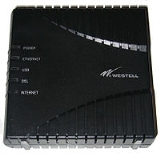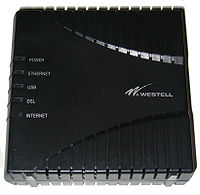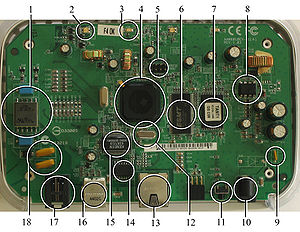
ADSL transceiver
Encyclopedia

Computer
A computer is a programmable machine designed to sequentially and automatically carry out a sequence of arithmetic or logical operations. The particular sequence of operations can be changed readily, allowing the computer to solve more than one kind of problem...
or router to a telephone circuit that has digital subscriber line
Digital Subscriber Line
Digital subscriber line is a family of technologies that provides digital data transmission over the wires of a local telephone network. DSL originally stood for digital subscriber loop. In telecommunications marketing, the term DSL is widely understood to mean Asymmetric Digital Subscriber Line ,...
service configured. Like other modem
Modem
A modem is a device that modulates an analog carrier signal to encode digital information, and also demodulates such a carrier signal to decode the transmitted information. The goal is to produce a signal that can be transmitted easily and decoded to reproduce the original digital data...
s, it is a type of transceiver
Transceiver
A transceiver is a device comprising both a transmitter and a receiver which are combined and share common circuitry or a single housing. When no circuitry is common between transmit and receive functions, the device is a transmitter-receiver. The term originated in the early 1920s...
. It is also called a DSL transceiver or ATU-R (for ADSL transceiver unit-remote). The acronym NTBBA, which stands for network termination broad band adapter, is also common in some countries.
Some DSL modems also manage the connection and sharing of the DSL service in a network, in this case, the unit is termed a DSL router or residential gateway
Residential gateway
A residential gateway is a home networking device, used as a gateway to connect devices in the home to the Internet or other WAN.It is an umbrella term, used to cover multi-function networking computer appliances used in homes, which may combine a DSL or cable modem, a firewall, a consumer-grade...
. DSL routers have a component that performs framing, while other components perform Asynchronous Transfer Mode
Asynchronous Transfer Mode
Asynchronous Transfer Mode is a standard switching technique designed to unify telecommunication and computer networks. It uses asynchronous time-division multiplexing, and it encodes data into small, fixed-sized cells. This differs from approaches such as the Internet Protocol or Ethernet that...
Segmentation and Reassembly
Segmentation and Reassembly
Segmentation and Reassembly refers to the process used to fragment and reassemble variable length packets into fixed length cells so as to allow them to be transported across Asynchronous Transfer Mode networks or other cell based infrastructures. Since ATM's payload is only 48 bytes, nearly every...
, IEEE 802.1D
IEEE 802.1D
802.1D is the IEEE MAC Bridges standard which includes Bridging, Spanning Tree and others. It is standardized by the IEEE 802.1 working group. It includes details specific to linking many of the other 802 projects including the widely deployed 802.3 , 802.11 and 802.16 standards.VLANs are not...
bridging and/or IP routing (including network address translation
Network address translation
In computer networking, network address translation is the process of modifying IP address information in IP packet headers while in transit across a traffic routing device....
). Typical user interfaces are Ethernet
Ethernet
Ethernet is a family of computer networking technologies for local area networks commercially introduced in 1980. Standardized in IEEE 802.3, Ethernet has largely replaced competing wired LAN technologies....
and Universal Serial Bus
Universal Serial Bus
USB is an industry standard developed in the mid-1990s that defines the cables, connectors and protocols used in a bus for connection, communication and power supply between computers and electronic devices....
(USB). Although a DSL modem working as a bridge does not need an IP address
IP address
An Internet Protocol address is a numerical label assigned to each device participating in a computer network that uses the Internet Protocol for communication. An IP address serves two principal functions: host or network interface identification and location addressing...
, it may have one assigned for management purposes.
Compared to voice-band modem
A DSL modem modulates high-frequency tones for transmission to a digital subscriber line access multiplexerDigital subscriber line access multiplexer
A digital subscriber line access multiplexer is a network device, located in the telephone exchanges of the telecommunications operators. It connects multiple customer digital subscriber line interfaces to a high-speed digital communications channel using multiplexing techniques...
(DSLAM), and receives and demodulates them from the DSLAM. It serves fundamentally the same purpose as the voice-band modem that was a mainstay in the late 20th century, but differs from it in important ways.
- DSL modems transfer data at a rate which is typically 10 to 20 times that of a voice-band modem.
- A single telephone line can be used for simultaneous voice and data with a DSL modem whereas a voice-band modem precludes simultaneous voice traffic.
- Most DSL modems are external to the computer and wired to the computer's EthernetEthernetEthernet is a family of computer networking technologies for local area networks commercially introduced in 1980. Standardized in IEEE 802.3, Ethernet has largely replaced competing wired LAN technologies....
port, or occasionally its USB port. Internal DSL modems with PCI interfacePeripheral Component InterconnectConventional PCI is a computer bus for attaching hardware devices in a computer...
are rare but available. - Microsoft WindowsMicrosoft WindowsMicrosoft Windows is a series of operating systems produced by Microsoft.Microsoft introduced an operating environment named Windows on November 20, 1985 as an add-on to MS-DOS in response to the growing interest in graphical user interfaces . Microsoft Windows came to dominate the world's personal...
and other operating systemOperating systemAn operating system is a set of programs that manage computer hardware resources and provide common services for application software. The operating system is the most important type of system software in a computer system...
s do not recognize external DSL modems connected by EthernetEthernetEthernet is a family of computer networking technologies for local area networks commercially introduced in 1980. Standardized in IEEE 802.3, Ethernet has largely replaced competing wired LAN technologies....
, and hence have no Property Sheet or other internal method to configure them. This is because the transceiver and computer are considered separate nodes in the LAN, rather than the transceiver being a device controlled by the computer (such as webcamWebcamA webcam is a video camera that feeds its images in real time to a computer or computer network, often via USB, ethernet, or Wi-Fi.Their most popular use is the establishment of video links, permitting computers to act as videophones or videoconference stations. This common use as a video camera...
s, mice, keyboards etc.). Most DSL modems and DSL modem-routers can be configured manually, using a Web pageWeb pageA web page or webpage is a document or information resource that is suitable for the World Wide Web and can be accessed through a web browser and displayed on a monitor or mobile device. This information is usually in HTML or XHTML format, and may provide navigation to other web pages via hypertext...
provided by the modem via the EthernetEthernetEthernet is a family of computer networking technologies for local area networks commercially introduced in 1980. Standardized in IEEE 802.3, Ethernet has largely replaced competing wired LAN technologies....
that the router connects to. The confs generally to open a browserBrowserTo browse or a browser may, among other concepts, refer to:*Browse, , a kind of orienting strategy in animals and human beings*Browsing , a type of herbivory*A user interface on a computer that allows navigation of objects...
, type the DSL modem's LAN IP address in the browser's address bar, and then press "Enter". However, DSL modems rarely need to be configured, because they are part of the physical layerPhysical layerThe physical layer or layer 1 is the first and lowest layer in the seven-layer OSI model of computer networking. The implementation of this layer is often termed PHY....
of computer networkComputer networkA computer network, often simply referred to as a network, is a collection of hardware components and computers interconnected by communication channels that allow sharing of resources and information....
s, simply forwarding data from one medium (CAT5Category 5 cableCategory 5 cable is a twisted pair cable for carrying signals. This type of cable is used in structured cabling for computer networks such as Ethernet. It is also used to carry other signals such as telephony and video. The cable is commonly connected using punch down blocks and modular connectors...
) to another one (telephone lineTelephone lineA telephone line or telephone circuit is a single-user circuit on a telephone communication system...
). - For external DSL modems connected by USB, Microsoft WindowsMicrosoft WindowsMicrosoft Windows is a series of operating systems produced by Microsoft.Microsoft introduced an operating environment named Windows on November 20, 1985 as an add-on to MS-DOS in response to the growing interest in graphical user interfaces . Microsoft Windows came to dominate the world's personal...
and other operating systemOperating systemAn operating system is a set of programs that manage computer hardware resources and provide common services for application software. The operating system is the most important type of system software in a computer system...
s generally recognize these as a Network interface controller. - For internal DSL modems, Microsoft WindowsMicrosoft WindowsMicrosoft Windows is a series of operating systems produced by Microsoft.Microsoft introduced an operating environment named Windows on November 20, 1985 as an add-on to MS-DOS in response to the growing interest in graphical user interfaces . Microsoft Windows came to dominate the world's personal...
and other operating systemOperating systemAn operating system is a set of programs that manage computer hardware resources and provide common services for application software. The operating system is the most important type of system software in a computer system...
s provide interfaces similar to those provided for voice-band modems. This is based on the assumption that in the future, as CPU speeds increase, internal DSL modems may become more mainstream. - DSL modems use frequencies from 25 kHz to above 1 MHz (see Asymmetric Digital Subscriber LineAsymmetric Digital Subscriber LineAsymmetric digital subscriber line is a type of digital subscriber line technology, a data communications technology that enables faster data transmission over copper telephone lines than a conventional voiceband modem can provide. It does this by utilizing frequencies that are not used by a voice...
), in order not to interfere with voice service which is primarily 0–4 kHz. Voice-band modems use the same frequency spectrum as ordinary telephones, and will interfere with voice service - it is usually impossible to make a telephone call on a line which is being used by a voice-band modem. - DSL modems vary in data speed from hundreds of kilobits per second to many megabits, while voice-band modems are nominally 56K modem56K modem56k modems are voiceband modems nominally capable of download speeds up to 56 kbit/s . In the late 1990s, they were the most popular access method for personal Internet usage, but their use had declined as broadband technologies such as DSL gained wider availability.-Speed:The 56 kbit/s...
s and actually limited to approximately 50 kbit/s. - DSL modems exchange data with only the DSLAM to which they are wired, which in turn connects them to the Internet, while most voice-band modems can dial directly anywhere in the world.
- DSL modems are intended for particular protocols and sometimes won't work on another line even from the same company, while most voice-band modems use international standards and can "fall back" to find a standard that will work.
Most of these differences are of little interest to consumers, except the greater speed of DSL and the ability to use the telephone even when the computer is online.
Because a single phone line commonly carries DSL and voice, DSL filter
DSL filter
A DSL filter is an analog low-pass filter installed between analog devices and a plain old telephone service telephone line, in order to prevent interference between such devices and a digital subscriber line service operating on the same line...
s are used to separate the two uses.
Hardware components

Integrated circuit
An integrated circuit or monolithic integrated circuit is an electronic circuit manufactured by the patterned diffusion of trace elements into the surface of a thin substrate of semiconductor material...
can be integrated onto one chip. Higher levels of integration have benefited DSL just as they benefited other computer hardware. A DSL modem requires the following for its operation; exactly what is on the circuit card and how it is arranged can change as technology improves:
- Power supplyPower supplyA power supply is a device that supplies electrical energy to one or more electric loads. The term is most commonly applied to devices that convert one form of electrical energy to another, though it may also refer to devices that convert another form of energy to electrical energy...
: Transformer and capacitor - Data connection and power circuitry (for example, USB, Ethernet, PCI)
- DSL digitalDigitalA digital system is a data technology that uses discrete values. By contrast, non-digital systems use a continuous range of values to represent information...
dataDataThe term data refers to qualitative or quantitative attributes of a variable or set of variables. Data are typically the results of measurements and can be the basis of graphs, images, or observations of a set of variables. Data are often viewed as the lowest level of abstraction from which...
pump - DSL analogAnalog signalAn analog or analogue signal is any continuous signal for which the time varying feature of the signal is a representation of some other time varying quantity, i.e., analogous to another time varying signal. It differs from a digital signal in terms of small fluctuations in the signal which are...
chip and line driver - Micro controller
- FilterElectronic filterElectronic filters are electronic circuits which perform signal processing functions, specifically to remove unwanted frequency components from the signal, to enhance wanted ones, or both...
- TransistorTransistorA transistor is a semiconductor device used to amplify and switch electronic signals and power. It is composed of a semiconductor material with at least three terminals for connection to an external circuit. A voltage or current applied to one pair of the transistor's terminals changes the current...
Service features
Apart from connecting to a DSL service, many modems offer additional integrated features, forming a residential gatewayResidential gateway
A residential gateway is a home networking device, used as a gateway to connect devices in the home to the Internet or other WAN.It is an umbrella term, used to cover multi-function networking computer appliances used in homes, which may combine a DSL or cable modem, a firewall, a consumer-grade...
:
- ADSL2 or ADSL2+ support
- RouterRoutingRouting is the process of selecting paths in a network along which to send network traffic. Routing is performed for many kinds of networks, including the telephone network , electronic data networks , and transportation networks...
functionality that includes Network Address TranslationNetwork address translationIn computer networking, network address translation is the process of modifying IP address information in IP packet headers while in transit across a traffic routing device....
(NAT) to share a single IPv4IPv4Internet Protocol version 4 is the fourth revision in the development of the Internet Protocol and the first version of the protocol to be widely deployed. Together with IPv6, it is at the core of standards-based internetworking methods of the Internet...
address. - An 802.11b, 802.11g or 802.11n wireless access pointWireless access pointIn computer networking, a wireless access point is a device that allows wireless devices to connect to a wired network using Wi-Fi, Bluetooth or related standards...
- A built-in switchNetwork switchA network switch or switching hub is a computer networking device that connects network segments.The term commonly refers to a multi-port network bridge that processes and routes data at the data link layer of the OSI model...
(typically 4 ports) - Virtual Private Network termination
- Dynamic Host Configuration ProtocolDynamic Host Configuration ProtocolThe Dynamic Host Configuration Protocol is a network configuration protocol for hosts on Internet Protocol networks. Computers that are connected to IP networks must be configured before they can communicate with other hosts. The most essential information needed is an IP address, and a default...
(DHCP) server - Dynamic DNSDynamic DNSDynamic DNS or DDNS is a term used for the updating in real time of Internet Domain Name System name servers to keep up to date the active DNS configuration of their configured hostnames, addresses and other information....
(Domain Name System) clients - Voice over Internet Protocol functionality including Quality of ServiceQuality of serviceThe quality of service refers to several related aspects of telephony and computer networks that allow the transport of traffic with special requirements...
(priority control for data flows between users)
See also
- Manuals for ADSL2+ Modems
- Digital home
- Residential gatewayResidential gatewayA residential gateway is a home networking device, used as a gateway to connect devices in the home to the Internet or other WAN.It is an umbrella term, used to cover multi-function networking computer appliances used in homes, which may combine a DSL or cable modem, a firewall, a consumer-grade...

